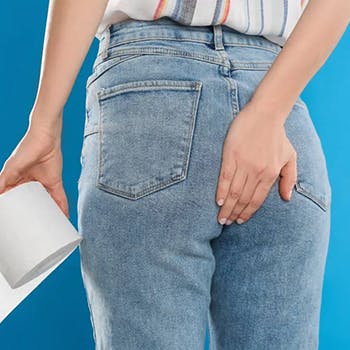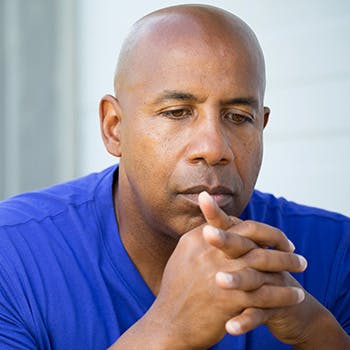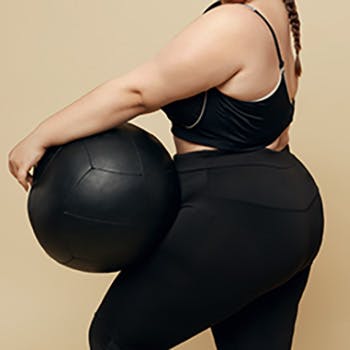Who Gets Hemorrhoids?

Hemorrhoids can be uncomfortable to deal with, and they are certainly not a fun topic to address. Thankfully, you’re probably not alone – they are much more common than you might think. Hemorrhoids are very common in both men and women, and about half of people over the age of 50 have them.1
Who gets hemorrhoids, and what can you do to prevent them? Learn more about the types of people who are most likely to get hemorrhoids.
What Are Hemorrhoids?
Technically speaking, everyone has hemorrhoids. Hemorrhoids are clusters of veins that lie just beneath the mucous membranes that line the lowest part of your rectum and anus.2 These veins don’t typically bother us until they become swollen and inflamed, and your symptoms will vary based on the type of hemorrhoids you have.2 Internal hemorrhoids develop in the lower rectum and are typically painless, but you may experience some rectal bleeding.2 External hemorrhoids develop under the skin around the anus and can be quite painful, especially if a blood clot forms inside the hemorrhoid.2
What Causes Hemorrhoids?
Hemorrhoids occur when the blood flow to and from the area is interfered, which causes the vessels to enlarge.2 This will likely happen if you strain during bowel movements or have long-term or chronic constipation or diarrhea.1 Straining during a bowel movement increases the pressure in the anal canal and pushes the hemorrhoids against the sphincter muscle.2 Hemorrhoids can also come as you get older because the connective tissues that hold them in place can weaken with age, causing them to bulge and prolapse.2
Do Men or Women Get Hemorrhoids More Often?
Hemorrhoids are common in both men and women, but women may have more risk factors for developing hemorrhoids. For instance, women who are pregnant or have just given birth are more likely to get hemorrhoids.3 About 30% to 40% of pregnant women get hemorrhoids, and the most common time for a woman to get hemorrhoids is during the third trimester or up to one month after giving birth.3 Women often get hemorrhoids during pregnancy and childbirth because the pressure of carrying a baby in the belly puts extra stress in the blood vessels that are in the pelvic area.1 Pregnant women are also at risk for constipation and have more blood in their bodies to support the fetus, which makes them more susceptible to developing hemorrhoids.3 Fortunately, most cases of pregnancy hemorrhoids go away after giving birth.3
What Groups Are at Higher Risk for Developing Hemorrhoids?
Anyone can get hemorrhoids, but some people are more at risk for getting it. The following groups of people are more at risk for getting hemorrhoids:4,5
- People who are obese: If you are obese or overweight, the extra weight on your body can add pressure to your stomach.
- People who regularly lift heavy objects: Lifting heavy objects can also add pressure to your lower extremities. This is especially true if you are a weightlifter or have to carry heavy objects for your job.
- People who push too hard too hard for bowel movements: Pushing too hard as a result of constipation or sitting on the toilet for too long can put you at risk as well.
- People who eat a low-fiber diet: Fiber is important for softening stools and helping you pass them easier. If you are lacking fiber in your diet, you may have a harder time passing stools and be more at risk for getting hemorrhoids.
How Can I Prevent and Treat Hemorrhoids?
Thankfully, hemorrhoid symptoms can be prevented and treated with simple home remedies and lifestyle changes.5 Some of these methods include:2,4,5
- Exercise. Dedicating some time to exercising each day can help stimulate bowel function. Exercise can also help you lose weight over time, which can also help to decrease your risk of getting hemorrhoids. 20-30 minutes of moderate aerobic exercise can go a long way with treating your hemorrhoids.
- Fiber. Eating more high-fiber foods or taking a fiber supplement can help to reduce the pressure on hemorrhoids. Fiber supplements can decrease hemorrhoidal bleeding and minimize enlarged veins. Make sure to eat plenty of beans, vegetables, fruits, wheat and whole-grain foods to help pass stools.
- Drink more water. Drinking enough water can help with constipation and make it easier to pass stools as well. Be sure to drink six to eight glasses of water every day.
- Go when you need to go. Waiting to pass a bowel movement can cause your stool to dry out, making it harder to pass. Make a habit of going to the restroom when you need to.
- Use over-the-counter treatments. Applying over-the-counter treatments for hemorrhoids can help with symptoms.If your hemorrhoid symptoms affect you outside of your home, bring a few packs of Preparation H Rapid Relief Totable Wipes with you.
Even if you’re at risk for hemorrhoids, your symptoms can be easily managed with a few simple steps. Find more tips on relieving hemorrhoid symptoms on the Preparation H website.



